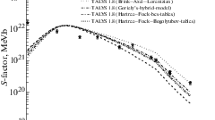Abstract
In this study, we have conducted an assessment of direct capture cross sections, astrophysical S-factors, phase shifts, and their derivatives at low energies within the framework of the potential model. We present the first investigation of the \(\mathrm{^{10}B(p,\gamma )^{11}C}\) reaction’s cross sections and astrophysical S-factors using the Woods–Saxon potential. The \(\mathrm{^{10}B(p,\gamma )^{11}C}\) reaction plays a key role in the production of carbon-11 in stars, providing insights into stellar evolution and the synthesis of elements in the universe. Our analysis focuses on the astrophysical S-factor for the electric dipole (E1) transition within the energy range of 0–500 keV. The chosen parametrization reproduces the available experimental and theoretical data for cross sections and astrophysical S-factors in this reaction accurately. Furthermore, we have extrapolated the S-factor values to zero energy (S(0)) for the \((5/2)^+\) to \((3/2)^-\), \((5/2)^-\) and \((7/2)^-\) energy levels. The calculated S(0) values are found to be 9.25 keV barn, 9.37 keV barn, and 8.54 keV barn, respectively.









Similar content being viewed by others
Data availability
This manuscript has no associated data or the data will not be deposited. [Authors’ comment: This is numerical study and no experimental method.]
References
Y. Fukuda et al., Phys. Rev. Lett. 81, 1562 (1998)
W. Beenakker et al., (1999). arXiv:astro-ph/9906298
A. Kafkarkou et al., Phys. Rev. C 89, 014601 (2014)
A.P. Tonchev et al., Phys. Rev. C 68, 045803 (2003)
W.H. Chung, G.B. Chadwick et al., Can. J. Phys. 34, 1 (1956)
M. Wiescher et al., Phys. Rev. C 28, 1431 (1983)
E. Padilla et al., Phys. Rev. Lett. 94, 122501 (2005)
J.M. Allmond et al., Phys. Rev. C 90, 034309 (2014)
H. Khalili et al., New Astron. 86, 101572 (2021)
S. Dubovichenko et al., Int. J. Mod. Phys. E 26, 1630009 (2017)
C.A. Bertulani, CPC 123 (2003)
Y. Xu et al., Nucl. Phys. A. 918, 61 (2013)
M. Born, Nature 486, 509 (2012)
J. Fox et al., PRC. 71, 055801 (2012)
C. Rolfs, R.E. Azuma, Nucl. Phys. A 227, 291 (1974)
E. Yildiz et al., EPJ Web Conf. 128, 1010 (2015)
J.T. Huang et al., ADNDT. 847, 96824 (2010)
P.J. Brussaard, P.W.M. Glaudemans, Shell Model Applications in Nuclear Spectroscopy (North Holland, Amsterdam, 1977)
W.A. Fowler, G.R. Caughlan, B.A. Zimmerman, Ann. Rev. Astron. Astrophys. 5, 525 (1967)
C.E. Rolls, W.S. Rodney, Cauldrons in the Cosmos (Chicago University, Chicago, 1988)
R.G. Breit, E.P. Wigner, Phys. Rev. 49, 519 (1936)
J.M. Blatt et al., Theoretical Nuclear Physics (Wiley, New York, 1962)
Author information
Authors and Affiliations
Corresponding author
Additional information
Communicated by Jérôme Margueron.
Appendices
Appendices
1.1 Appendix A: Electromagnetic transition
The matrix elements for transition \(J_0M_0\longrightarrow JM\) are calculated from the following equation:
where O\(_{if}(E\lambda )\) the reduced matrix elements are equal to
In this equation:
The transition \( M_{\lambda } \) is as follows [17]:
where \(\mathcal{I}_{ij}\) and \(\mathcal{T}_{ij}\) are defined as follows:
The M1 and E2 transitions can are used for [18]
and
In this equation k is photon number and \({\mathcal{H}}_{if}\) (i,f=are a and b nucleous) given by:
In above equation \(\psi _l\) is continum wave function describing the lth partial wave while \(\psi _f\) is the radial p-wave bound-state wave function.
1.2 Appendix B: Resonance strength
The resonance strength is showned by
\(F_\Gamma \) is defined by \(\frac{\Gamma _p\Gamma _\gamma }{\Gamma _{tot}}\). For the case of narrow resonances, \((\omega _\gamma )_R\) can be used for calculation expectation value of product \(\sigma v\) \((\langle \sigma v\rangle )\).
and for broad resonance we can use:
where \(C(T)=4(\frac{2}{\pi m_{ab}(k_BT)^3})^{\frac{1}{2}} \). The resonance cross section for a narrow resonance is approximated by the Wigner-Bright expression [19,20,21,22].
The radiative capture cross section for the reaction \(a+b\longrightarrow c+\gamma \), where \((\pi \lambda )\) \(=E,(M)\)=E(electric) or M(magnetic) transition, is defined as follows:
where \(I_{ac}\) =\(\dfrac{2(2I_c+1)}{(2I_a+1)(2s+1)}\). In the phase shift section, we can use the following formula:
In the case of a(b,\(\gamma \))c charged particles(a anb b) S(E) is presented to be a slowly varying function compared to cross section in energy for non resonant nuclear reactions. In this senario, S(E) can be evaluated in a McLaurin series:
Rights and permissions
Springer Nature or its licensor (e.g. a society or other partner) holds exclusive rights to this article under a publishing agreement with the author(s) or other rightsholder(s); author self-archiving of the accepted manuscript version of this article is solely governed by the terms of such publishing agreement and applicable law.
About this article
Cite this article
Dalvand, M., Khalili, H. Examination of gamma radiation from \(\mathrm{^{10}B(p,\gamma )^{11}C}\) reaction at low energies. Eur. Phys. J. A 60, 16 (2024). https://doi.org/10.1140/epja/s10050-024-01238-1
Received:
Accepted:
Published:
DOI: https://doi.org/10.1140/epja/s10050-024-01238-1




